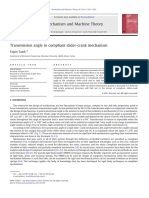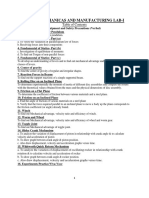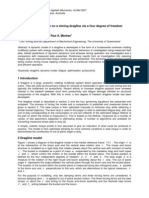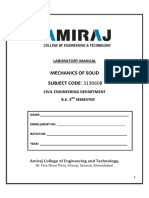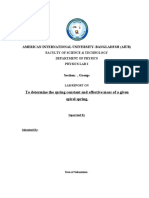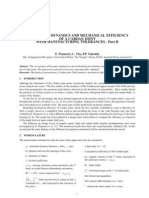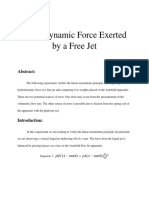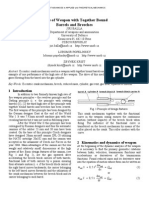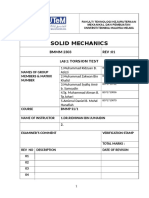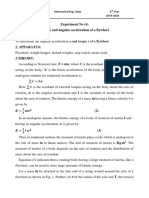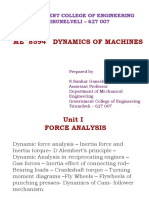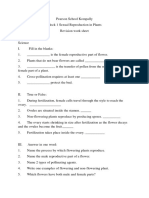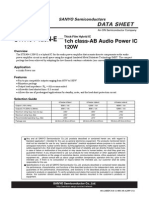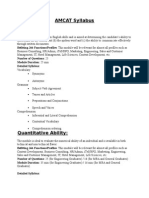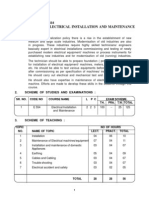A Slider-Crank Experiment To Determine The Action of Static Forces
A Slider-Crank Experiment To Determine The Action of Static Forces
Uploaded by
Razali YusoffCopyright:
Available Formats
A Slider-Crank Experiment To Determine The Action of Static Forces
A Slider-Crank Experiment To Determine The Action of Static Forces
Uploaded by
Razali YusoffOriginal Title
Copyright
Available Formats
Share this document
Did you find this document useful?
Is this content inappropriate?
Copyright:
Available Formats
A Slider-Crank Experiment To Determine The Action of Static Forces
A Slider-Crank Experiment To Determine The Action of Static Forces
Uploaded by
Razali YusoffCopyright:
Available Formats
A slider-crank experiment to determine the
action of static forces
T. W. Ng
Faculty of Engineering, Engineering Block EA 07-32, National University of Singapore,
9 Engineering Drive 1, Singapore 117576
E-mail: engngtw@nus.edu.sg
Abstract A simple experiment to demonstrate the action of static forces in a slider-crank mechanism
is described. Despite the apparent simplicity of the set-ups used, the experiment was able to produce
measurements that were close to those predicted by kinetics analysis theory. More importantly, it was
highly successful in helping students grasp the fundamental concepts of static forces operating in
slider-crank mechanisms in an experiential manner.
Keywords slider crank; kinetics; theory of machines; engineering experiment
One of the most important and common mechanisms is the slider-crank. It is found
in pumps, compressors, steam engines, feeders, crushers, punches and injectors.
Furthermore, the slider-crank mechanism is central to diesel and gasoline internal
combustion engines, which play an indispensable role in modern living.
The kinematics and kinetics of the slider-crank mechanism is well explained in
many textbooks on the mechanics of machines [1, 2]. Recently, there has been some
work reported on the use of specific software [3] and spreadsheets [2] to assist in
creating diagrams for students to understand the kinematics of slider-crank mecha-
nisms. However, a proper understanding of the kinetics is just as crucial as the kine-
matics of mechanisms. While a mechanism is designed primarily to provide motion,
it is expected to bear loads throughout its service life. In terms of the kinetics aspect
of mechanisms, physical experimentation is arguably more appropriate than soft-
ware in conveying the essential concepts to students. The loads borne by the slider-
crank mechanism may be static or dynamic. This paper details the development of
an experiment to illustrate the action of static forces in a slider-crank mechanism.
Theory
Fig. 1 shows a slider-crank mechanism. Let the force acting on the slider be Fp, the
velocity of the slider be vp, the force acting perpendicularly to the crank be Fc, and
the velocity of the crank at C be vc. In the absence of friction, conservation of energy
gives:
Fp v p = Fc vc (1)
If PC is produced to intersect a vertical to O at M, replacing vp and vc, as described
in equation (A3) of the Appendix, from equation (1), with OC and OM gives:
Fp OM = Fc OC = T (2)
International Journal of Mechanical Engineering Education 31/4
318 T. W. Ng
Fig. 1 Schematic description of a slider-crank mechanism.
where T is the torque developed at the crank. From the geometry of the system, we
have:
r sin q = l sin f (3)
Values of r, l and q are typically known. Hence, this allows f to be determined using:
r sin q ˆ
f = sin -1 Ê (4)
Ë l ¯
The geometry of the system also provides the relation:
OM
tan f = (5)
r cos q + l cos f
From equations (2) and (5), the slider force, Fp, required to maintain equilibrium
with a crank torque, T, in the absence of friction is given by:
T
Fp = (6)
tan f (r cos q + l cos f )
Under the action of force Fp on the piston, a side thrust, Fs, develops. It is expressed
by:
Fs = Fp tanf (7)
Suppose that the slider is not frictionless, but has a coefficient of friction m with
the motion guides of the mechanism. The effective force, Fp¢, needed at the slider
to maintain equilibrium with the crank torque, T, is now given by:
Fp¢ = Fp - mFp tan f (8)
The coefficient of friction can be determined as shown in Fig. 2. Suppose the
slider has mass m and is tilted at some angle, j, to the horizontal. At the instant
when the object first starts to slide,
International Journal of Mechanical Engineering Education 31/4
Slider-crank experiment 319
Fig. 2 Free body diagram showing the forces acting on a mass on an inclined plane.
mg sin j = mmg cos j (9)
In other words,
m = tan j (10)
Another important parameter in any linkage mechanism is the transmission angle.
The transmission angle determines the effective transfer of torque from an input to
output linkage. In the slider-crank mechanism, this can be determined by geometry
using:
b = 180 ∞ -f - q (11)
Experimental equipment and procedure
The central set-up used in the experiment was a slider-crank mechanism assembly
that comprised (see Fig. 3) a base, circular crank, cord connected to the circular
crank, connecting rod, slider, and force transducer attached to the slider. The other
items used in the experiment were a vernier calliper, a fixture to anchor the force
transducer, two C clamps, a plumb, six detachable weighting pieces of 0.25 kg mass
each, and a strain gauge meter (P-3500 model by the Measurements Group). The
force transducer was based on a strain gauge proving ring design, wherein the strain
gauge used was a single element with 120 ohms resistance, 2.12 gauge factor, and
3 mm gauge length. The quarter-bridge configuration was applied for all readings
made on the strain gauge meter.
The first part of the experiment involved determining the relevant physical
parameters of the slider-crank mechanism. To do so, the connecting rod was
detached, and the vernier calliper used to measure the connecting rod length l, crank
radius r, and radius of the circular crank.
International Journal of Mechanical Engineering Education 31/4
320 T. W. Ng
Fig. 3 The experimental slider-crank mechanism assembly.
The second part of the experiment involved determining the coefficient of fric-
tion between the slider and motion guides of the mechanism. The slider mechanism,
with the connecting rod detached, was placed on the table. The plumb was then hung
from the centre of the circular crank. As soon as the plumb was no longer swing-
ing, the mechanism was slowly titled (see Fig. 4). At the instant the slider first started
to move, the angle j was recorded and m calculated using equation (10).
The third part of the experiment involved calibrating the force transducer. For this
part, the connecting rod was reconnected to the slider-crank mechanism and the
mechanism firmly attached on the table using a clamp, in the manner shown in Fig.
5. The wires from the force transducer were attached to the strain gauge meter. The
weights were hung from the force transducer, from 0 to 1.5 kg, at intervals of
0.25 kg. At each loading interval, the strain gauge reading was recorded.
In the last part of the experiment, the action of the static forces was investigated.
The clamp was removed and reattached firmly on the slider-crank mechanism, as
shown in Fig. 6. For the first reading, the crank angle was set at 40 °. The force trans-
ducer on the slider-crank mechanism was anchored to the fixture. The second clamp
was used to ensure that the fixture was stationary. A 0.5 kg mass was then applied
by hanging two pieces of the detachable weight at the end of the cord wrapped
around the circular crank. This would produce a torque equal to the product of weight
and radius of the circular crank. The strain gauge reading was then recorded. This
process was repeated by increasing the crank angle at intervals of 10 ° to 130 °.
International Journal of Mechanical Engineering Education 31/4
Slider-crank experiment 321
Fig. 4 The experimental set-up used to determine the coefficient of friction.
Fig. 5 The experimental set-up used to calibrate the force transducer.
International Journal of Mechanical Engineering Education 31/4
322 T. W. Ng
Fig. 6 The experimental set-up used to determine the action of the static forces.
Experimental results and discussion
As anticipated, students found the experiment easy to understand and conduct. They
were encouraged to record their data in a spreadsheet program like Excel to facili-
tate the plotting of graphs and statistical analysis of results.
The following results were taken from a sample run of the experiment. From
the first part of the experiment, the connecting rod, crank radius and radius of the
circular crank were found to be 72 mm, 25 mm, and 27 mm, respectively. From the
second part of the experiment, the slider first moved when the assembly was tilted
at 45 °. This meant that the coefficient of friction was 1. This value was used in the
theoretical calculations of F and F¢.
Table 1 shows the results obtained from the third part of the experiment, to cali-
brate the strain-gauge force transducer. From these results, a graph of strain against
force was plotted (see Fig. 7). The trend of the graph was noticeably linear. In fact,
a computation of the R-squared value (used to determine the degree of linearity
[4]) revealed a value of 0.9998, which was very close to the maximum limit of 1.
This graph was then used to determine the force readings in the next part of the
experiment.
Table 2 shows the results related to the fourth part of the experiment, which
included values of F and F¢ calculated from theory and F¢ determined by experi-
ment. From these results, a graph of these three parameters was plotted against the
crank angle (see Fig. 8). It can be seen that the theoretical and experimental values
International Journal of Mechanical Engineering Education 31/4
Slider-crank experiment 323
TABLE 1 Values from the experiment to calibrate the
force transducer
Weight Strain reading
(N) (¥10-6)
2.45 50
4.91 95
7.36 148
9.81 190
12.27 238
14.72 290
Fig. 7 Graph of strain against force from the force transducer calibration experiment.
of F¢ corresponded closely. This demonstrated the validity of the experiment. From
the distributions of F and F¢, the effect of friction on static equilibrium is clearly
demonstrated. One interesting question that can be posed about this comparison is
the effect of starting crank torques in engines. Students can be guided to understand
how friction leads to the reduction in effective driving force at the pistons. The last
column in Table 2 gives the values of the transmission angle in relation to the crank
angle in the experiment. Students should be guided to observe that the lowest force
needed to maintain equilibrium occurred when the transmission angle was 90 °. In
many books on the mechanics of machines, this angle is often stated (sometimes
without proof) as the most effective in the transmission of torque for linkage
mechanisms.
International Journal of Mechanical Engineering Education 31/4
324 T. W. Ng
TABLE 2 Values from the experiment to determine the action of the static forces
q F: theory F¢: theory F¢: experiment b
(degrees) (N) (N) (N) (degrees)
10 45.47 31.13 – 166.54
20 23.33 15.97 – 153.18
30 16.24 11.12 – 140.00
40 12.95 8.87 9.22 127.10
50 11.23 7.69 7.65 114.57
60 10.35 7.09 7.26 102.49
70 10.01 6.86 6.87 90.95
80 10.11 6.92 7.06 80.00
90 10.59 7.25 7.46 69.67
100 11.49 7.87 8.04 59.99
110 12.89 8.82 10.20 50.94
120 14.94 10.23 12.16 42.48
130 17.97 12.31 – 34.55
140 22.63 15.49 – 27.08
150 30.42 20.83 – 19.97
160 45.95 31.46 – 13.15
Fig. 8 Graph of F (theory), F¢ (theory), and F¢ (experimental) against crank angle
in the experiment to determine the action of static forces.
International Journal of Mechanical Engineering Education 31/4
Slider-crank experiment 325
Notwithstanding the closeness of the experimental and theoretical values in this
sample experimental run, students should be encouraged to comment on possible
causes of error. These may include inaccuracies from (a) friction at the mechanism
joints, (b) incorrect setting of the crank angle, and (c) incorrect registration of strain
due to poor clamping.
Some practical points should be noted with regard to the smooth running of this
experiment. As weights were used, students should be warned to be careful in case
they fall on some unsuspecting feet. Constant reminder is hence recommended.
During the fourth part of the experiment, it was necessary to remove the mass and
reapply the load a few times to ensure repeatable measurements. Readjustment of
the anchor fixture may be needed if different readings are obtained each time. Stu-
dents should also be reminded to keep within the range of crank angles prescribed.
By intuition, angles close to 0 ° and 180 ° will result in very large values of F¢. This
will result in a sudden failure at some parts of the assembly. With these points in
mind, careful experimentation should ensure that the set-ups are be re-usable over
many times.
Conclusions
A cost-effective experiment to demonstrate the action of static forces in slider-crank
mechanisms was found to yield results with good accuracy. The experiment was
easy to conduct and contributed much towards the experiential learning of students.
References
[1] K. J. Waldron and G. L. Kinzel, Kinematics, Dynamics, and Design of Machinery (John Wiley, New
York, 1999).
[2] D. H. Myszka, Machines and Mechanisms: Applied Kinematics Analysis (Prentice Hall, Upper Saddle
River, NJ, 1999).
[3] W. P. Boyle and K. Liu, ‘The offset slider crank: kinematic pseudograph analysis’, International
Journal of Engineering Education, 13 (1997), 198–203.
[4] B. S. Gottfried, Spreadsheet Tools for Engineers (McGraw-Hill, Boston, 1998).
Appendix
Consider the graphical construction for velocity in a slider-crank mechanism shown
in Fig. A1. Let w be the angular velocity of crank OC and W the angular velocity
of the connecting rod, PC. If I is the instantaneous centre for PC,
v p c vc v p
W= = = (A1)
PC IC IP
Simple rearrangement gives:
IP
v p = vc (A2)
IC
International Journal of Mechanical Engineering Education 31/4
326 T. W. Ng
Fig. A1 Graphical construction of velocity components in a slider-crank mechanism.
If PC is produced to intersect a vertical to O at M, triangles PIC and OCM are similar.
Hence, substituting IP and IC for OM and OC gives:
v p OM
= (A3)
vc OC
International Journal of Mechanical Engineering Education 31/4
You might also like
- En 619 - A1 - Continuous Handling Equipment and Systems - Safety and EMC Requirements For Equipment For Mechanical Handling of Unit LoadsDocument77 pagesEn 619 - A1 - Continuous Handling Equipment and Systems - Safety and EMC Requirements For Equipment For Mechanical Handling of Unit LoadsAnonymous Z5wCELpNo ratings yet
- PMC GearlessDocument72 pagesPMC Gearlessمحمدحماد63% (8)
- Spring Constant Measurement - Static Dynamic MethodDocument7 pagesSpring Constant Measurement - Static Dynamic MethodPrasetyaJayaputra50% (2)
- Operationmaintenance ManualDocument26 pagesOperationmaintenance ManualRicardo Burgos0% (1)
- Qpro Ex en PDFDocument22 pagesQpro Ex en PDFShahjad Mansuri85% (27)
- PHY133 Angular MomentumDocument6 pagesPHY133 Angular MomentumAngel RodriguezNo ratings yet
- Coopertitchener Trifilar1Document30 pagesCoopertitchener Trifilar1api-24490620450% (2)
- 1-s2.0-S0094114X11001273-mainDocument10 pages1-s2.0-S0094114X11001273-maincrowndy lilacNo ratings yet
- ME-222 Mechanics Manufacturing Lab-IDocument50 pagesME-222 Mechanics Manufacturing Lab-IMuhammad Haseeb JavedNo ratings yet
- Helical SpringDocument7 pagesHelical SpringSalam Albaradie100% (4)
- Adaptive State Controller For Inverted Pendulum: Nenad Muškinja, Boris TovornikDocument6 pagesAdaptive State Controller For Inverted Pendulum: Nenad Muškinja, Boris TovornikNeagu AdrianNo ratings yet
- Optimising Slew Torque On A Mining Dragline Via A Four Degree of Freedom Dynamic ModelDocument6 pagesOptimising Slew Torque On A Mining Dragline Via A Four Degree of Freedom Dynamic Modelsoh_vakiliNo ratings yet
- AB Robust Report PendulumInverted1Document16 pagesAB Robust Report PendulumInverted1Sebastian ReyesNo ratings yet
- Mos Lab-ManualDocument34 pagesMos Lab-Manualdaxchaudhary880No ratings yet
- Em PracticalDocument7 pagesEm PracticaldanielNo ratings yet
- Curved I-Girder Design: Esign TheDocument19 pagesCurved I-Girder Design: Esign TheLikhon BiswasNo ratings yet
- 547 002 PDFDocument19 pages547 002 PDFLikhon BiswasNo ratings yet
- Damping Lab 1Document60 pagesDamping Lab 1Robert Lau Yik SiangNo ratings yet
- Lab 4 Mass-Spring System - v3Document13 pagesLab 4 Mass-Spring System - v3sairafiNo ratings yet
- 54 - RostamzadehDocument4 pages54 - RostamzadehRidwan FadlikaNo ratings yet
- Modeling and Altitude Control of Quad-Rotor UAVDocument6 pagesModeling and Altitude Control of Quad-Rotor UAVescanusNo ratings yet
- American International University-Bangladesh (Aiub)Document9 pagesAmerican International University-Bangladesh (Aiub)Shoaib Khan100% (2)
- IMAC XV 15th Int 15-49-3 Optimization Techniques RotordynamicsDocument7 pagesIMAC XV 15th Int 15-49-3 Optimization Techniques Rotordynamicsuamiranda3518No ratings yet
- Kinematics, Dynamics and Mechanical Efficiency of A Cardan Joint With Manufacturing Tolerances - Part IiDocument6 pagesKinematics, Dynamics and Mechanical Efficiency of A Cardan Joint With Manufacturing Tolerances - Part IiDenis MataNo ratings yet
- Mass Moment of Inertia of FlywheelDocument8 pagesMass Moment of Inertia of Flywheelabdulaziz67% (3)
- Free Jet LabDocument7 pagesFree Jet Labaeroscribble0% (1)
- Lindsey Hines Final Report PDFDocument21 pagesLindsey Hines Final Report PDFclimax1364No ratings yet
- Krzysztof Michalczyk: THE Archive OF Mechanical Engineering Vol. Lvi 2009 Number 4Document14 pagesKrzysztof Michalczyk: THE Archive OF Mechanical Engineering Vol. Lvi 2009 Number 4Namik VežićNo ratings yet
- ERT2016 Lab Sheet 20112012 MechanicsDocument7 pagesERT2016 Lab Sheet 20112012 MechanicsKesava ShankarNo ratings yet
- Pendulo Doble MotorDocument10 pagesPendulo Doble Motorjuan alarconNo ratings yet
- Dynamics ManualDocument30 pagesDynamics ManualRiyaz AhmedNo ratings yet
- Experiment 106: Uniform Circular MotionDocument7 pagesExperiment 106: Uniform Circular MotionJasmin DionisioNo ratings yet
- PS195 QLab 6Document6 pagesPS195 QLab 6John Vissel F. ParaisoNo ratings yet
- HW 2Document2 pagesHW 2KapulurujagadeeshNo ratings yet
- Christophgruber Mechatronics2012Document8 pagesChristophgruber Mechatronics2012Hamza NasirNo ratings yet
- Lab 4 - Torsion Test (1) SXSCDDocument18 pagesLab 4 - Torsion Test (1) SXSCDThaneswaran BaluNo ratings yet
- EM Final Manual_241209_175859Document23 pagesEM Final Manual_241209_175859MECH 503 ShivamNo ratings yet
- II B.tech I Sem Question Bank For r18Document30 pagesII B.tech I Sem Question Bank For r18saiharish634No ratings yet
- Analysis of Dynamic Effects in A Rotary Kiln System Used For Iron ProductionDocument9 pagesAnalysis of Dynamic Effects in A Rotary Kiln System Used For Iron ProductionLuis Gabriel L. CatalanNo ratings yet
- Dynamics of Machinery3Document18 pagesDynamics of Machinery3dearsaswatNo ratings yet
- Nonlinear Controller Design For Inverted Pendulum Cart System On Uncertain SlopeDocument9 pagesNonlinear Controller Design For Inverted Pendulum Cart System On Uncertain SlopeDavid KunNo ratings yet
- Lab Manual 2023 24Document83 pagesLab Manual 2023 24areejarshad257No ratings yet
- Dynamic Lab3a-Briefing SheetDocument9 pagesDynamic Lab3a-Briefing SheetchauguleNo ratings yet
- Drive of Weapon With Together Bound Barrels and BreechesDocument6 pagesDrive of Weapon With Together Bound Barrels and Breechesihv69No ratings yet
- Modelling and Dynamic Identification of 3 DOF Quanser HelicopterDocument6 pagesModelling and Dynamic Identification of 3 DOF Quanser HelicopterosdacavNo ratings yet
- Spring Cont PDFDocument7 pagesSpring Cont PDFphooolNo ratings yet
- LAB 2 Torsion Test v1Document14 pagesLAB 2 Torsion Test v1Nur Aiman Norahim100% (1)
- Slider Crank MechanismDocument22 pagesSlider Crank MechanismSmart100% (1)
- Dynamics Model of Backhoe Devices Considering Excavation Load ForDocument10 pagesDynamics Model of Backhoe Devices Considering Excavation Load ForIdha AprianNo ratings yet
- Hysteretic Damping Modelling by Nonlinear Kelvin-Voigt ModelDocument6 pagesHysteretic Damping Modelling by Nonlinear Kelvin-Voigt ModelPaul Pinedo VilcahuamánNo ratings yet
- Dynamic Modelling and Experimental Identification of Four Rotors Helicopter ParametersDocument7 pagesDynamic Modelling and Experimental Identification of Four Rotors Helicopter Parametersali.azim1380No ratings yet
- Quadcopter Dynamics, Simulation, and ControlDocument18 pagesQuadcopter Dynamics, Simulation, and Controldemos2011No ratings yet
- Experiment No (4) Torque and Angular Acceleration of A FlywheelDocument4 pagesExperiment No (4) Torque and Angular Acceleration of A FlywheelNihad MohammedNo ratings yet
- Me 8594 Dynamics of Machinery Unit 1 Online Video LectureDocument42 pagesMe 8594 Dynamics of Machinery Unit 1 Online Video LecturesankarNo ratings yet
- Helical Springs ReportDocument11 pagesHelical Springs ReportHeather TatNo ratings yet
- LEP 1.3.19 Laws of Gyroscopes / 3-Axis Gyroscope: Related Topics ProblemsDocument3 pagesLEP 1.3.19 Laws of Gyroscopes / 3-Axis Gyroscope: Related Topics ProblemsDenis PANo ratings yet
- Rotational Dynamics and Rotational Inertia v2Document7 pagesRotational Dynamics and Rotational Inertia v2aDnan haiDerNo ratings yet
- Momentum and Energy in Collisions: AbstractDocument9 pagesMomentum and Energy in Collisions: AbstractattiqueurrehnanNo ratings yet
- Modeling of Complex Systems: Application to Aeronautical DynamicsFrom EverandModeling of Complex Systems: Application to Aeronautical DynamicsNo ratings yet
- Introduction of PC200-8 Hybrid Hydraulic ExcavatorsDocument6 pagesIntroduction of PC200-8 Hybrid Hydraulic ExcavatorsDhony NgaluNo ratings yet
- Pflex Sg002 en PDocument132 pagesPflex Sg002 en PAnton PankratovNo ratings yet
- Hammam Abu ShoshehDocument2 pagesHammam Abu ShoshehHammam Abu ShoshehNo ratings yet
- Mechanism Worksheet PDFDocument2 pagesMechanism Worksheet PDFv4djbgykkmNo ratings yet
- ANSI Device Numbers PDFDocument1 pageANSI Device Numbers PDFPutra Kusuma HarditoNo ratings yet
- G5-Science HYE Compiled Revision Worksheet With Answer KeyDocument23 pagesG5-Science HYE Compiled Revision Worksheet With Answer KeyRevanth kumarNo ratings yet
- DW Series 2015Document20 pagesDW Series 2015kris CadwellNo ratings yet
- STK404-120N-E: 1ch class-AB Audio Power IC 120WDocument11 pagesSTK404-120N-E: 1ch class-AB Audio Power IC 120WgapjgNo ratings yet
- 7X 14168Document3 pages7X 14168Syed AhammadNo ratings yet
- Science 6 DLL-simple Machine - COT Ko PANCHIDocument64 pagesScience 6 DLL-simple Machine - COT Ko PANCHIPANCHITA MASIGANNo ratings yet
- B Tech Mechanical Engineering Syllabus For Batch 2013-14Document30 pagesB Tech Mechanical Engineering Syllabus For Batch 2013-14ra44993541No ratings yet
- Metrology Course Oulines.10batchDocument4 pagesMetrology Course Oulines.10batchTariq AslamNo ratings yet
- Fixed Concrete Boom - Tower PumpDocument60 pagesFixed Concrete Boom - Tower PumpAnura WeerasingheNo ratings yet
- AMCAT SyllabusDocument13 pagesAMCAT SyllabusRati ShankarNo ratings yet
- Sello Energizados PDFDocument24 pagesSello Energizados PDFhufuents-1No ratings yet
- Lab 4Document3 pagesLab 4Misbah BatoolNo ratings yet
- Consult Form Jpsme Form and Pos TemplateDocument5 pagesConsult Form Jpsme Form and Pos TemplateRiel FalogmeNo ratings yet
- Fluid Power Part1Document101 pagesFluid Power Part1absolutebajwa100% (1)
- Jit, Jimma University: Computer Aided Engineering AssignmentDocument8 pagesJit, Jimma University: Computer Aided Engineering AssignmentGooftilaaAniJiraachuunkooYesusiinNo ratings yet
- Hotel Project ReportDocument97 pagesHotel Project ReportRavi ThakurNo ratings yet
- P357 With Fanuc 04PC User Pre-Installation Guide Rev 4 - 0 PDFDocument35 pagesP357 With Fanuc 04PC User Pre-Installation Guide Rev 4 - 0 PDFParvezNo ratings yet
- Final Year Project 2023Document28 pagesFinal Year Project 2023PANDURANG PARABNo ratings yet
- Course Structure For M.Tech in Mechanical Engineering: Specialization: Machine DesignDocument10 pagesCourse Structure For M.Tech in Mechanical Engineering: Specialization: Machine DesignSandip BarikNo ratings yet
- Attachment "A" - Property ListDocument4 pagesAttachment "A" - Property ListsacatongaNo ratings yet
- Electrical Installation and Maintenance: Course Code: E-554 Course Name: 1. RationaleDocument14 pagesElectrical Installation and Maintenance: Course Code: E-554 Course Name: 1. Rationalekaran976No ratings yet
- Allen Steam TurbinesDocument15 pagesAllen Steam TurbinesEduardo PedrazaNo ratings yet







